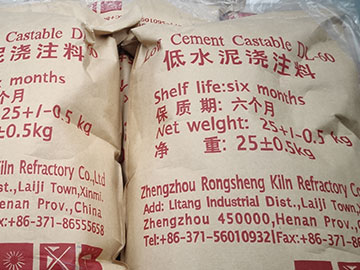Low cement castables are widely used in the steel industry because of their advantages such as high density, good fire resistance, and excellent slag resistance. At the same time, low cement castables also have some disadvantages. Such as instantaneous coagulation, delayed hardening instantaneous loss of fluidity, etc. Failure to achieve the construction effect will cause losses to users and cause worse effects. So how to use low cement castables efficiently?

Problems that easily occur during the construction of low cement castables. Since low-cement castables contain various additives, they are easily affected by external influences during construction. Its operating performance and quality are prone to changes over time. The main manifestations of on-site construction include excessive condensation, delayed hardening, and reduced fluidity. In the past, low cement castables have experienced phenomena such as instantaneous setting, delayed hardening, and instantaneous loss of fluidity during construction. RS Kiln Refractory manufacturer found through research that the above problems are related to the construction performance of low cement castable itself.
(1) Condensation too fast and too slow
The setting and hardening process of low-cement castables is caused by hydration bonding and cohesion bonding, or cohesion bonding alone. After the water-reducing agent in the castable is determined, the fluidity of the castable will also vary greatly depending on the amount of pure calcium aluminate cement added. When the addition amount exceeds 9%, the flow value of the castable is lower than 110mm, and the normal construction fluidity of the castable can no longer be guaranteed. This may be due to the excessive amount of pure calcium aluminate cement that accelerates the setting and hardening process of the castable.
The following measures can be taken to solve the aging changes of low cement castables. (1) Double-sealed packaging, especially in the rainy season or when the storage time is long. (2) Choose a dispersant with a strong dispersing ability. (3) Consider adding some newly opened packages of cement during construction and mixing. (4) Use a powerful mixer to mix and control the mixing time. (5) Add an accelerator or retarder to adjust the hardening speed of the castable. (6) In terms of on-site management, prevent moisture absorption during storage.
At present, the most effective way to solve the aging change of low cement castables on site is to add a setting accelerator or retarder to the castables. The accelerators and retarder used, especially the carbonate accelerator and citric acid retarder, are used in small quantities have significant effects, and have no adverse effects on the strength of the castable at all temperatures.

(2) Instantaneous loss of liquidity
Instantaneous loss of fluidity sometimes occurs during castable construction. The analyzed reason should be due to the failure of the water-reducing agent in the castable material or improper operation during construction.
Water reducing agent is a surface active substance. The surface activity of inorganic water-reducing agents is not significant. It mainly increases the zeta potential through chemical adsorption, effectively destroying the flocculation structure between particles. Give full play to the filling effect of micro powder and the lubrication effect of free water to increase fluidity. The anionic group N ionized by the organic water-reducing agent in water has a strong surface activity. Its lipophilic end is adsorbed on the surface of colloidal particles by physical adsorption and enters the fixed adsorption layer. The ζ potential increases in the negative direction, and the oil-repellent ends repel each other to achieve the purpose of dispersion. However, the water-reducing agent easily absorbs the moisture in the castable ingredients during the storage process and causes deliquescence and hydrolysis, which increases the acidity of the castable ingredients. This results in loss of water-reducing effect and instantaneous fluidity loss. Therefore, measures should be taken during the production and storage of castables. For example, use a water-reducing agent with poor hygroscopicity, separate the water-reducing agent from the castable, etc. At the same time, instantaneous fluidity loss may also occur during the construction of high-tech castables, especially when the mixing time is too long. We believe that the reason should be caused by the temperature rise caused by long-term stirring.
In addition, when using low-cement castables, avoid adding too much water. If too much water is added, its performance will decrease and even cause the following hazards:
- Reduced intensity. Adding too much water will make the water-cement ratio of low-cement castables too high. This results in a reduction in its strength and reduces the load-bearing capacity and service life of the refractory material.
- Decreased slag resistance. Adding too much water to low-cement castables will lead to a decrease in slag resistance. It is susceptible to slag erosion and reduces the service life of refractory materials.
- Poor thermal shock performance. Adding too much water to low-cement castables will result in a decrease in the thermal shock properties of the material. It is prone to cracking, peeling and other phenomena, which greatly shortens the service life of the material.
- Construction difficulty increases. Adding too much water will result in increased flowability of low cement castables. Problems such as slurry leakage and looseness are prone to occur during construction, which affects the quality of the project.
According to the above content, it is known that adding too much water to low-cement castables will have a serious impact on its performance and service life. During construction, the amount of water added must be strictly followed to ensure the quality and performance of the material.
Before construction and storage, pay attention to moisture-proof and avoid contact with water; when using, control the amount of water added and use additives rationally. Storage and use in strict accordance with the construction instructions will basically enable low-cement castables to effectively exert their advantages in high-temperature industrial furnace linings. Contact RS Kiln Refractory Factory for a free quote and sample of low cement castables.
